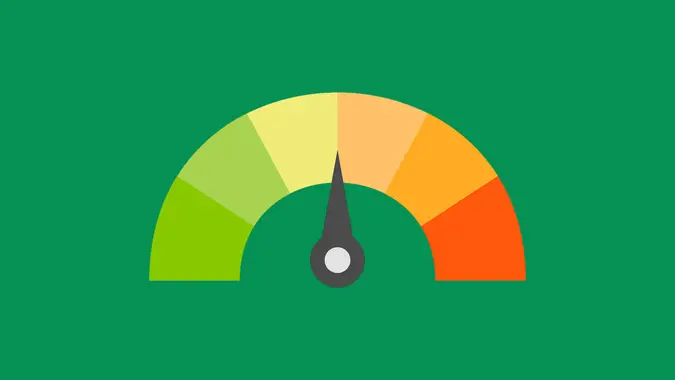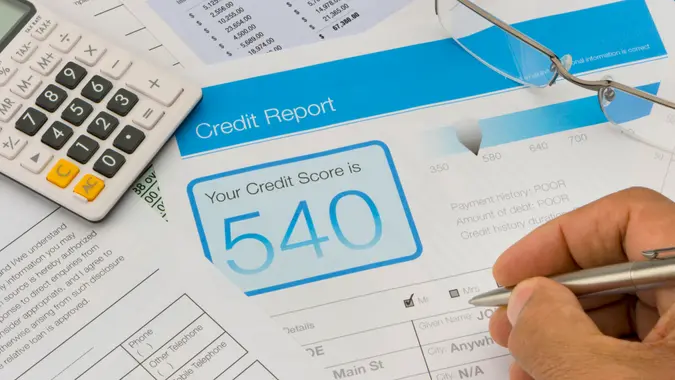How to Report Credit Card Fraud in 4 Simple Steps

Commitment to Our Readers
GOBankingRates' editorial team is committed to bringing you unbiased reviews and information. We use data-driven methodologies to evaluate financial products and services - our reviews and ratings are not influenced by advertisers. You can read more about our editorial guidelines and our products and services review methodology.

20 Years
Helping You Live Richer

Reviewed
by Experts

Trusted by
Millions of Readers
Noticing an unfamiliar charge on your credit card statement or getting an unexpected fraud alert from your bank can instantly set off alarm bells. If you’re feeling anxious or confused about what to do next, you’re not alone — but the good news is, reporting credit card fraud is simpler than you might think.
Knowing exactly how to report credit card fraud can protect your finances, prevent further damage to your credit, and help you regain control quickly.
Let’s break down exactly what steps you need to take, clearly and simply, so you can fix this stressful situation and move forward confidently.
How to Spot Credit Card Fraud Right Away
Before jumping into reporting fraud, it helps to recognize it early. Watch closely for these common red flags:
- Unfamiliar Charges: Purchases from stores or websites you’ve never visited.
- Bank Alerts: Texts or emails from your credit card company about suspicious activity.
- Declined Card Transactions: Being unexpectedly denied at checkout, especially if you know your balance is sufficient.
Set up automatic transaction alerts through your bank’s mobile app. You’ll get instant notifications if something suspicious happens, making it easier to act quickly.
Step 1: Call Your Credit Card Company Immediately
The first and most important step in reporting credit card fraud is contacting your credit card issuer as soon as possible.
Here’s exactly what you should do:
- Locate your card issuer’s phone number: It’s typically printed on the back of your credit card or listed on their official website.
- Call right away: Clearly state that you suspect fraudulent activity on your account.
- Explain the details: Let them know if your card was lost, stolen, or if you simply see charges you don’t recognize.
- Confirm your recent legitimate purchases: This helps the company quickly identify fraudulent charges.
In most cases, your credit card company will immediately freeze or cancel your card, issue a replacement and begin a fraud investigation, usually without any cost to you.
Step 2: Dispute Fraudulent Charges Formally
After alerting your card issuer, it’s essential to officially dispute any unauthorized charges to ensure you aren’t financially liable.
Follow these simple steps:
- Log in to your account online or via the mobile app.
- Mark fraudulent charges. Your bank’s online system usually has a simple dispute form.
- Provide a brief explanation, such as, “I never authorized this transaction and have no relationship with the merchant.”
Under U.S. law, your liability for unauthorized charges is typically limited to just $50, but most credit card companies waive even this amount if you report promptly.
Always save your dispute confirmation details, like screenshots or emails, as evidence in case you need it later.
Step 3: Place a Fraud Alert With Credit Bureaus
Protecting your overall credit score is also critical after experiencing credit card fraud. Placing a fraud alert with one of the three major credit bureaus — Experian, Equifax or TransUnion — is simple and provides extra security.
Here’s how you can do it quickly:
- Contact just one of the bureaus (they’re legally required to notify the other two for you).
- Request a fraud alert on your credit report. This requires lenders to verify your identity thoroughly before opening new credit accounts in your name.
Here are the bureau contacts to make this process easy:
- Experian: Visit Experian Fraud Center
- Equifax: Visit Equifax Fraud Alert
- TransUnion: Visit TransUnion Fraud Victim Assistance
Setting a fraud alert is completely free and typically stays on your credit report for one year.
Step 4: Report the Fraud to the FTC for Extra Protection
Filing a credit card fraud report with the Federal Trade Commission (FTC) isn’t required, but it’s highly recommended. The FTC provides official documentation that can help you prove your case if a bank or lender ever questions you.
Here’s exactly how to report credit card fraud to the FTC:
- Visit IdentityTheft.gov and fill out the short online report.
- Get an official Identity Theft Report immediately, plus a personalized action plan to secure your identity moving forward.
Having this report handy makes resolving identity or credit issues smoother and quicker, especially if the fraud involves larger sums of money or multiple accounts.
How to Protect Yourself from Future Credit Card Fraud
While experiencing fraud can be unsettling, there are simple ways to reduce your risk and stay safer in the future:
- Enable Real-Time Transaction Alerts: Get immediate notifications of unusual purchases, so you can act fast if fraud occurs again.
- Shop Securely Online: Always look for “https://” and a padlock icon when shopping online, indicating a secure connection.
- Avoid Saving Card Information on Unfamiliar Websites: Entering your card manually each time helps limit your exposure.
- Regularly Check Your Credit Card Statements: Weekly reviews can help spot suspicious activity early.
- Use Strong, Unique Passwords: Create different passwords for each financial account to prevent multiple breaches.
- Consider Credit Monitoring Services: Especially helpful if you’ve experienced fraud before; services like Experian or LifeLock provide ongoing protection.
Final Thoughts to GO: Take Control When Fraud Happens
Realizing your credit card has been compromised is stressful — but knowing exactly how to report credit card fraud can help you feel calmer and more in control.
To quickly recap the steps:
- Contact your card issuer immediately.
- Dispute fraudulent transactions formally.
- Place a fraud alert with credit bureaus.
- Report the fraud to the FTC online.
Taking these four straightforward steps will help you recover quickly, protect your finances, and safeguard your credit for the future.
Want more guidance on keeping your credit safe? Check out these helpful resources:
- How Often Should You Check Your Credit Report?
- Quick Ways to Boost Your Credit Score
- Understanding the Fair Credit Reporting Act
By acting fast, staying informed, and using this clear step-by-step guide, you can confidently handle credit card fraud, regain your peace of mind and protect your finances for the future.
FAQs About Reporting Credit Card Fraud
Still have questions? Here are quick answers to some common concerns:- How long do I have to report credit card fraud?
- Ideally, report fraud immediately. You're most protected when you notify your credit card company within 60 days of seeing the fraudulent charge.
- Will reporting credit card fraud hurt my credit score?
- No. Reporting fraud protects your credit by stopping unauthorized activity quickly. Fraudulent transactions themselves won’t damage your score permanently once resolved.
- What if I lost my card but no charges have appeared yet?
- Report a lost or stolen card right away, even if no charges are visible yet. Your issuer can freeze your account and prevent unauthorized purchases before they happen.
- Do I need to file a police report for credit card fraud?
- Typically, a police report isn't required for credit card fraud involving small amounts. However, it's smart to file one if your identity has been seriously compromised or larger amounts are involved.
The information is accurate as of March 27, 2025.
Editorial Note: This content is not provided by any entity covered in this article. Any opinions, analyses, reviews, ratings or recommendations expressed in this article are those of the author alone and have not been reviewed, approved or otherwise endorsed by any entity named in this article.
Our in-house research team and on-site financial experts work together to create content that’s accurate, impartial, and up to date. We fact-check every single statistic, quote and fact using trusted primary resources to make sure the information we provide is correct. You can learn more about GOBankingRates’ processes and standards in our editorial policy.
- ReportFraud.FTC.gov "website"
- Experian "Fraud Alert"
- Equifax "Equifax Consumer Services Center"
- TransUnion "Fraud Victim Resources"
- IdentityTheft.gov "website"
 Written by
Written by  Edited by
Edited by 






















